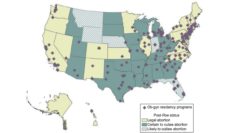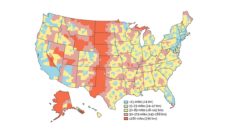Public Health Post: Let’s start with Dobbs v. Jackson Women’s Health Organization. From your perspective as a researcher of policy and social disparities, what was most surprising about that decision?
Paula Lantz: First, several Supreme Court justices had said in confirmation hearings that they considered Roe to be settled as precedent in law. Second, some of the language in the decision references reproductive health care beyond abortion. That makes people nervous about implications for contraception and other types of reproductive care.
For me, the most surprising thing in the wake of the Dobbs decision is what’s happening at such a rapid pace at the state level. The legislation that’s being introduced, debated, and enacted in many states shows an utter lack of understanding of what causes abortion in the first place, which is unintended pregnancy. It shows a shameful ignorance of the whole landscape of women’s reproductive health care. It shows an interference with established evidence-based medicine and a blatant disregard for the health and socioeconomic welfare of families and children in the United States.
As a result of this decision, what do you think are best- and worst-case scenarios regarding abortion access in the U.S. over the next couple of years?
The legal landscape is very complex, and every state is different. The battlegrounds are not just between legislatures and judicial systems, which come down to each state’s constitutions and protections. The battlegrounds are also between legislatures and the executive branch. They will take years and years to work out, if they are ever settled. But what we know right now is that at least 25 states already have or are on their way to having very restrictive abortion policies. This impacts a huge proportion of people, with huge repercussions for health and social welfare.
The clinical landscape is already being negatively affected. Healthcare systems are nervous. Physicians in states with restrictive abortion policy are really hamstrung in the care they can provide, having to check in with lawyers. A recent survey of physicians and medical students showed that many are concerned about practicing in states with restrictive abortion policies. This could create huge deserts of obstetric, gynecologic, and reproductive health care, including specialty care for gynecological cancer and other health issues. That’s really concerning.
How does restricted abortion access impact historically marginalized and vulnerable groups?
Maternal mortality rates are likely to increase. In the U.S., rates of maternal mortality are much higher than other countries, especially among African American women. It’s predicted that for African American women and other women of color, death rates related to pregnancy will increase even more.
About half of women seeking abortion care in the U.S. live in poverty and already have children. We know from studies that restricting abortion access will increase the rate at which women don’t complete their educational plans. It will increase the number of families living in financial distress, the number of children born into poverty, and the number of families who must file for bankruptcy. All this cascades into increasing the number of people needing to rely on social safety net systems for food, housing, health care, income security. We also know that it’ll increase the number of children who experience abuse and neglect and then end up in foster care. The cascade of this decision has ripple effects on families and children throughout their entire lives.
Restrictive abortion policy touches quite a few areas that people aren’t necessarily thinking about when discussing abortion. Are there any other consequences of this ruling that are important for us to consider in public health?
It’s important to understand what’s driving the need for abortion in the U.S.: very high rates of unintended pregnancy, as an absolute metric but also relative to other countries. More than half of pregnancies in the U.S. are unintended, with higher rates among young people in poverty and people of color.
The way to reduce abortions is not to ban them but to think about what’s causing unintended pregnancies. First and foremost, it’s the lack of quality education about contraception and access to affordable and effective methods. What can we do to prevent unintended pregnancies? Talk about contraception, make it affordable, improve access. Contraception does fail – that’s another cause of unintended pregnancy. But there are methods with lower failure rates than others, including long-acting methods, such as IUDs. Dealing with the problem of gender-based violence in the U.S. is also going to be important. Unintended pregnancies resulting from rape and incest is heart-wrenching, but it’s a very, very small percentage of unintended pregnancies. What is much more common is an unintended pregnancy resulting from coercion and intimate relationship violence.
The same policymakers taking away abortion access are not inclined to expand access to affordable contraception, family planning services, or sex education. And investments in the socioeconomic welfare of the population must also be made.
Lantz recently spoke about her work at a three-part Public Health Conversation hosted by Boston University School of Public Health. View the recording here.
Photo provided














